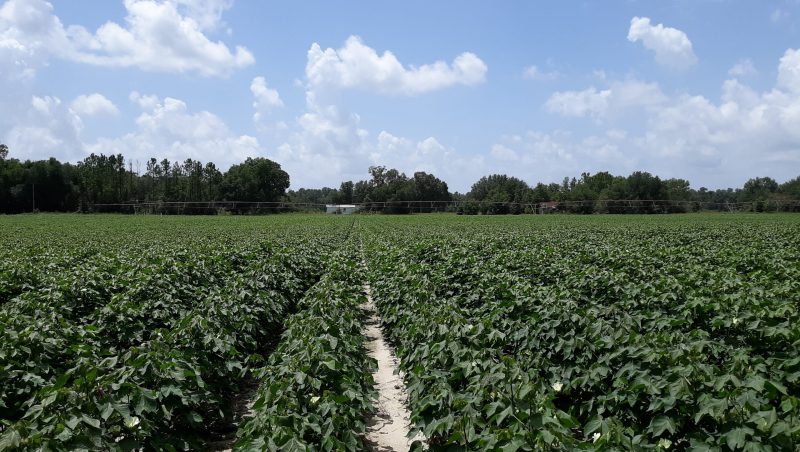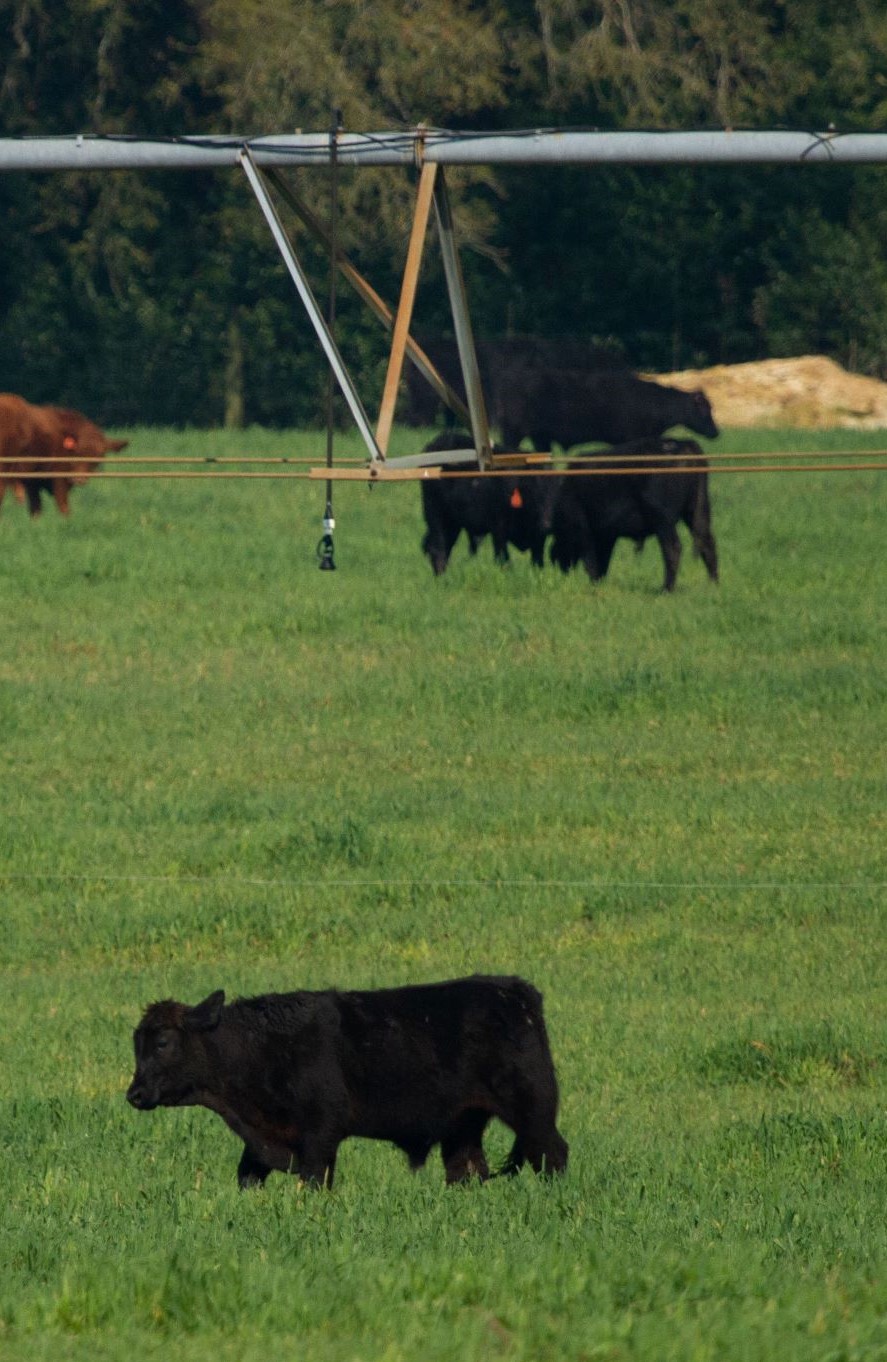
FDACS, NRCS and the Northwest Florida Water Management District all provide technical and financial assistance for producers to implement BMPs. BMPs include improving irrigation and fertilizer use efficiency, protecting water resources, improving soil health, and improving pollinator and wildlife habitat. Each agency has its own guidelines on what they provide assistance for. Image: Irrigated cotton field in Malone, FL. Credit Andrea Albertin, UF/IFAS
Producers have implemented Best Management Practices (BMPs) that maintain or improve water quality, quantity and soil conditions on their farms for many years. Multiple agencies in our region recognize this and offer financial assistance to reduce the cost to the farmer for implementation. Producers are encouraged to work with agency staff to determine which practices are feasible on their operation.
Implementing BMPs is voluntary in most areas of the Panhandle, but for producers in an area with a Basin Management Action Plan (BMAP) like the Jackson Blue Springs Basin, the 2016 Water Bill requires BMPs be implemented, and verification by the Florida Department of Agriculture (FDACS).
–
Florida Department of Agriculture and Consumer Services (FDACS)
Recommended BMPs are outlined by FDACS in BMP manuals specific to agricultural commodities. Manuals are available for citrus, cow/calf, dairy, equine, nurseries, poultry, sod, specialty fruit and nut crops, vegetable and agronomic crops, and state imperiled wildlife. BMP Manuals can be downloaded from the FDACS Agricultural Best Management Practices web page.
FDACS’ Office of Ag and Water Policy (OAWP) field staff work one-on-one with producers to develop a feasible BMP plan, identifying the BMPs that are applicable on their agricultural operation. Their funding is largely for cost-share of equipment purchases.
Cost-share funding falls under three broad BMP categories: (1) nutrient management, (2) irrigation management and (3) water resources protection. Examples of funded equipment for improved nutrient management include conservation tillage equipment, GPS guidance systems, variable rate applicators, and banders for side dressing. To improve irrigation efficiency they provide cost-share for soil moisture sensors, irrigation retrofits, nozzle packages, smart irrigation control panels, and more. BMPs for water resource protection include cattle exclusion fences and alternate water sources, like solar wells, among others.
FDACS funds 75% of the equipment cost, which they reimburse once the producer purchases the item. The cost share reimbursement cap is $50,000. Cost-share is distributed on a case-by-case basis. Producers must be enrolled in the BMP Program to receive funds. Applications are accepted year-round.
Contact your local FDACS field office for information about the BMP program.
–
USDA-Natural Resources Conservation Service (NRCS)

NRCS provides financial assistance for cover crops on a per acre payment rate. Image: Winter cattle grazing is incorporated into a row crop system. Credit: J Ashmore, FDACS.
NRCS offers financial assistance for producers through three programs: EQIP (General Environmental Quality Incentives Program), CSP (Conservation Stewardship Program) and RCPP (Regional Conservation Partnership Program). NRCS staff work with farmers and ranchers to develop conservation plans to address natural resource concerns. Depending on the producer’s objectives, these plans can include erosion control and improving soil conditions, improved nutrient management and water quality, increased water-use efficiency, and improving wildlife habitat.
The conservation plan outlines practices to achieve specified goals, and NRCS provides technical and financial assistance to carry them out. For example, NRCS provides financial assistance for cover crops, no-till management, cattle exclusion fences along streams and alternative watering systems, including wells. Other funded BMPs include soil sampling, irrigation retrofits, cross-fencing for grazing management, waste storage facilities for dairies, forest stand improvement, increasing pollinators and improving bird habitat. These are just a few examples – there are many more.
Financial assistance is provided through a payment rate established for each individual conservation practice. For example, per foot for fencing, per acre for cover crops and weed treatment, per item for a well, etc. They generally do not offer financial assistance for equipment.
Contact your local NRCS office for more information on technical and financial assistance provided. Applications for assistance are accepted year-round.
–
Northwest Florida Water Management District (NWFWMD)
The Water Management District’s BMP cost-share program is for producers within the Jackson Blue Springs/Merritts Mill Pond Basin. It focuses on increasing efficiency in irrigation and fertilizer use. Producers must be enrolled in the FDACS BMP Program to qualify.
The District reimburses 75% of the cost of eligible BMPs. These include: irrigation system improvements, pump upgrades (high to low pressure), remote control systems for irrigation, control panel upgrades, endgun controls, fertigation systems, and other precision agriculture tools and services as they relate to irrigation systems.
The District provides an interactive map so you can see if your farm is within the Jackson Blue Springs Basin. They provide additional information about assistance available for producers on their Water Resources for Agriculture webpage.
For more information, contact Dave Cambron at (850) 539-5999, or by email at Dave.Cambron@nwfwater.com
- What to Do if Sinkholes Open on Your Property - November 15, 2024
- Crop Farmers Implementing BMPs in the Chipola River Basin - May 24, 2024
- The Granberry Farm: Sustainably Managing a Cattle Ranch in the Chipola River Basin - January 5, 2024
